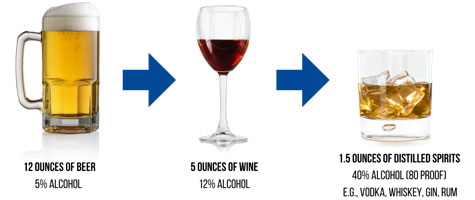Alcohol, Tobacco and Other Drugs
The University of North Georgia expects all students to follow all applicable laws and policies regarding alcohol and other drug use. At the same time, we recognize that some students will drink or use other substances despite this expectation. The only truly safe use is no use, but for those who do use, we believe it is important to know how to minimize the risk of harm to self and others from drinking or drug use.
Decisions about substance use are personal. It’s your right and responsibility to make decisions for yourself. How often and how much you drink or use other drugs is your own personal choice. Therefore, it is important to make informed choices and understand potential consequences if you choose to engage in these activities.
Alcohol
What Is A Standard Drink?
In the United States, a standard drink is about 0.6 fluid ounces of alcohol. The body can metabolize about one drink per hour. A drink equals one 12 oz. beer, one 5 oz. glass of wine, or 1.5 oz. of 80-proof liquor.

Understanding Blood Alcohol Content
Blood Alcohol Content (BAC) is the concentration of alcohol in the blood and is typically expressed as a percentage. For example, a BAC of 0.10% means there is one part alcohol for every 1,000 parts blood.
- Amount of alcohol consumed
- Duration/Speed of consumption
- Physiological differences between biological-males and biological-females
- Body type/weight
- If food is present in the stomach
- If other medications are present in the body
Cannabis
The Effects of Cabbanis
The active chemical in cannabis is Tetrahydrocannabinol, commonly known as THC. Cannabis can be categorized as a depressant, a hallucinogen, or a stimulant. As a result, it is difficult to detect how one will react after using. When a person smokes marijuana, THC quickly passes from the lungs into the bloodstream. The blood carries the chemical to the brain and other organs throughout the body. The body absorbs THC more slowly when the person eats or drinks it. In that case, they generally feel the effects after 30 minutes to one hour.
Cannabis Use Can Affect:
- Concentration
- Short and long term memory
- Ability to learn
- Sleep (interrupts REM for several days after use)
- Altered senses (for example, seeing brighter colors)
- Altered sense of time
- Changes in mood
- Impaired memory
- Impaired body movement
- Difficulty with thinking and problem-solving
- Hallucinations (when taken in high doses)
- Delusions (when taken in high doses)
- Psychosis (risk is highest with regular use of high potency marijuana)
Marijuana also affects brain development. When people begin using marijuana as teenagers, the drug may impair thinking, memory, and learning functions and affect how the brain builds connections between the areas necessary for these functions. New research suggests that marijuana's effects can last up to three days.
Source: National Institute on Drug Abuse
Prescription Drugs
| Examples | Method of Action | Potential Effects of Misuse | |
|---|---|---|---|
| Stimulants | Adderall, Ritalin, Concerta, Focalin, Dexedrine, medications prescribed to treat Attention Deficit Hyperactivity Disorder (ADHD). Energy drinks are also categorized as stimulants because they contain substances that are intended to produce the effects of a stimulant. | Increases alertness, attention and energy, elevates blood pressure, increases heart rate and respiration |
|
| Central Nervous System (CNS) Depressants | Valium and Xanax. Sometimes referred to as sedatives and tranquilizers. Used for treatment of anxiety and sleep disorders | Slow down the brain’s activity. Produces a drowsy or calming feeling. |
|
| Opioids | Codeine, Oxycodone, OxyContin, Percocet. Prescription narcotics prescribed for post-surgical pain relief and management of acute and chronic pain. | Attach to receptors in the brain that block the perception of pain |
|
Source: National Institute on Drug Abuse
The misuse of prescription drugs includes:
- Using higher doses or more frequently than prescribed
- Taking medication prescribed to someone else
- Alternating the delivery of the medication (e.g. crushing and snorting)
- Using a prescription medication to get high